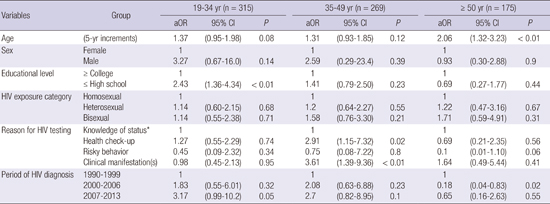1. Joint United Nations Programme on HIV/AIDS. Global report: UNAIDS report on the global AIDS epidemic: 2012. Geneva: United Nations & AIDS;2012.
2. Korea Centers for Disease Control and Prevention. The surveillance report for HIV/AIDS in Korea. Osong: Korea Centers for Disease Control and Prevention;2013.
3. Kee MK, Lee JH, Kim GJ, Choi BS, Hong KJ, Lee JS, Kim SS. Decrease of initial CD4+ T-cell counts at the time of diagnosis of HIV infection in Korea; 1988-2006. Int J STD AIDS. 2010; 21:120–125.
4. Lee JH, Kim GJ, Choi BS, Hong KJ, Heo MK, Kim SS, Kee MK. Increasing late diagnosis in HIV infection in South Korea: 2000-2007. BMC Public Health. 2010; 10:411.
5. Phillips A, Pezzotti P. CASCADE Collaboration. Short-term risk of AIDS according to current CD4 cell count and viral load in antiretroviral drug-naive individuals and those treated in the monotherapy era. AIDS. 2004; 18:51–58.
6. Egger M, May M, Chêne G, Phillips AN, Ledergerber B, Dabis F, Costagliola D, D'Arminio Monforte A, de Wolf F, Reiss P, et al. Prognosis of HIV-1-infected patients starting highly active antiretroviral therapy: a collaborative analysis of prospective studies. Lancet. 2002; 360:119–129.
7. Marks G, Crepaz N, Senterfitt JW, Janssen RS. Meta-analysis of high-risk sexual behavior in persons aware and unaware they are infected with HIV in the United States: implications for HIV prevention programs. J Acquir Immune Defic Syndr. 2005; 39:446–453.
8. Choe PG, Park WB, Song JS, Kim NH, Park JY, Song KH, Park SW, Kim HB, Kim NJ, Oh MD. Late presentation of HIV disease and its associated factors among newly diagnosed patients before and after abolition of a government policy of mass mandatory screening. J Infect. 2011; 63:60–65.
9. Smith RD, Delpech VC, Brown AE, Rice BD. HIV transmission and high rates of late diagnoses among adults aged 50 years and over. AIDS. 2010; 24:2109–2115.
10. Chin-Hong PV, Vittinghoff E, Cranston RD, Buchbinder S, Cohen D, Colfax G, Da Costa M, Darragh T, Hess E, Judson F, et al. Age-specific prevalence of anal human papillomavirus infection in HIV-negative sexually active men who have sex with men: the EXPLORE study. J Infect Dis. 2004; 190:2070–2076.
11. The Korean Society for AIDS. Clinical guidelines for the diagnosis and treatment of HIV/AIDS in HIV-infected Koreans. Infect Chemother. 2011; 43:89–128.
12. Zoufaly A, an der Heiden M, Marcus U, Hoffmann C, Stellbrink H, Voss L, van Lunzen J, Hamouda O. ClinSurv Study Group. Late presentation for HIV diagnosis and care in Germany. HIV Med. 2012; 13:172–181.
13. Johnson M, Sabin C, Girardi E. Definition and epidemiology of late presentation in Europe. Antivir Ther. 2010; 15:Suppl 1. 3–8.
14. Xun H, Kang D, Huang T, Qian Y, Li X, Wilson EC, Yang S, Jiang Z, Gong C, Tao X, et al. Factors associated with willingness to accept oral fluid HIV rapid testing among most-at-risk populations in China. PLoS One. 2013; 8:e80594.
15. Li X, Lu H, Raymond H, Sun Y, Jia Y, He X, Fan S, Shao Y, McFarland W, Xiao Y. Untested and undiagnosed: barriers to HIV testing among men who have sex with men, Beijing, China. Sex Transm Infect. 2012; 88:187.
16. Lee JY, Hwang JS, Goh UY, Kee MK, Kim JY. Prediction of HIV and AIDS incidence using a back-calculation model in Korea. Korean J Prev Med. 2002; 35:65–71.
17. Pratt G, Gascoyne K, Cunningham K, Tunbridge A. Human immunodeficiency virus (HIV) in older people. Age Ageing. 2010; 39:289–294.
18. Blas MM, Alva IE, Cabello R, Carcamo C, Kurth AE. Risk behaviors and reasons for not getting tested for HIV among men who have sex with men: an online survey in Peru. PLoS One. 2011; 6:e27334.
19. Yu L. Understanding information inequality: making sense of the literature of the information and digital divides. J Librariansh Inf Sci. 2006; 38:229–252.







 PDF
PDF ePub
ePub Citation
Citation Print
Print



 XML Download
XML Download